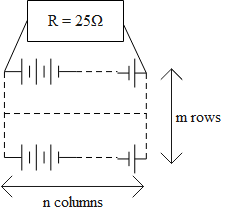
Given , 100 cells, each of e.m.f. 5 V and internal resistance \[1\,\Omega \] are to be arranged so as to produce maximum current in a \[25\,\Omega \]resistance. Each row is to contain an equal number of cells. The number of rows should be:-
A. 2
B. 4
C. 5
D. 10
Answer
521.1k+ views
Hint: The resistance equals the internal resistance times the number of columns by the number of rows. The total number of cells equals the product of the number of rows and the columns. Using these 2 equations we will compute the value of the number of rows of the resistors.
Formula used:
\[R=\dfrac{n}{m}r\]
Complete answer:
From the given information, we have the data as follows.
100 cells, each of e.m.f. 5 V and internal resistance \[1\,\Omega \]are to be arranged so as to produce maximum current in a \[25\,\Omega \]resistance.
\[\begin{align}
& m\times n=100 \\
& R=25\Omega \\
& r=1\Omega \\
& \varepsilon =5V \\
\end{align}\]
The diagram representing the arrangement of cells is given as follows.

The formula for computing the resistance of cells is given as follows.
\[R=\dfrac{n}{m}r\]…… (a)
Where R is the resistance, n is the number of columns, m is the number of rows and r is the internal resistance.
As there are a total of 100 cells, so, we will represent this statement in terms of a mathematical expression as follows.
\[n\times m=100\]
Represent the above equation in terms of ‘m’.
\[m=\dfrac{100}{n}\]…… (1)
Substitute the values of the resistance and the internal resistance in the equation (a).
\[25=\dfrac{n}{m}\times 1\]……. (2)
Substitute the equation (1) in the equation (2). So, we get,
\[\begin{align}
& 25=\dfrac{n}{{}^{100}/{}_{n}}\times 1 \\
& \therefore 25=\dfrac{{{n}^{2}}}{100} \\
\end{align}\]
Continue further computation.
\[\begin{align}
& {{n}^{2}}=100\times 25 \\
& \Rightarrow {{n}^{2}}=2500 \\
\end{align}\]
Therefore, the number of columns is,
\[\therefore n=50\]
Now substitute the value of the number of columns in the equation (1).
\[\begin{align}
& m=\dfrac{100}{50} \\
& \therefore m=2 \\
\end{align}\]
\[\therefore \] The value of the number of rows is 2.
Thus, option (A) is correct.
Note:
The total number of cells equals the product of the number of rows and the columns. The resistance equals the internal resistance times the number of columns by the number of rows. The internal resistance value will always be less than the resistance of a resistor.
Formula used:
\[R=\dfrac{n}{m}r\]
Complete answer:
From the given information, we have the data as follows.
100 cells, each of e.m.f. 5 V and internal resistance \[1\,\Omega \]are to be arranged so as to produce maximum current in a \[25\,\Omega \]resistance.
\[\begin{align}
& m\times n=100 \\
& R=25\Omega \\
& r=1\Omega \\
& \varepsilon =5V \\
\end{align}\]
The diagram representing the arrangement of cells is given as follows.

The formula for computing the resistance of cells is given as follows.
\[R=\dfrac{n}{m}r\]…… (a)
Where R is the resistance, n is the number of columns, m is the number of rows and r is the internal resistance.
As there are a total of 100 cells, so, we will represent this statement in terms of a mathematical expression as follows.
\[n\times m=100\]
Represent the above equation in terms of ‘m’.
\[m=\dfrac{100}{n}\]…… (1)
Substitute the values of the resistance and the internal resistance in the equation (a).
\[25=\dfrac{n}{m}\times 1\]……. (2)
Substitute the equation (1) in the equation (2). So, we get,
\[\begin{align}
& 25=\dfrac{n}{{}^{100}/{}_{n}}\times 1 \\
& \therefore 25=\dfrac{{{n}^{2}}}{100} \\
\end{align}\]
Continue further computation.
\[\begin{align}
& {{n}^{2}}=100\times 25 \\
& \Rightarrow {{n}^{2}}=2500 \\
\end{align}\]
Therefore, the number of columns is,
\[\therefore n=50\]
Now substitute the value of the number of columns in the equation (1).
\[\begin{align}
& m=\dfrac{100}{50} \\
& \therefore m=2 \\
\end{align}\]
\[\therefore \] The value of the number of rows is 2.
Thus, option (A) is correct.
Note:
The total number of cells equals the product of the number of rows and the columns. The resistance equals the internal resistance times the number of columns by the number of rows. The internal resistance value will always be less than the resistance of a resistor.
Recently Updated Pages
Master Class 11 Business Studies: Engaging Questions & Answers for Success

Master Class 11 Computer Science: Engaging Questions & Answers for Success

Master Class 11 Maths: Engaging Questions & Answers for Success

Master Class 11 Chemistry: Engaging Questions & Answers for Success

Master Class 11 Economics: Engaging Questions & Answers for Success

Master Class 11 Accountancy: Engaging Questions & Answers for Success

Trending doubts
What is meant by exothermic and endothermic reactions class 11 chemistry CBSE

10 examples of friction in our daily life

One Metric ton is equal to kg A 10000 B 1000 C 100 class 11 physics CBSE

1 Quintal is equal to a 110 kg b 10 kg c 100kg d 1000 class 11 physics CBSE

Difference Between Prokaryotic Cells and Eukaryotic Cells

What are Quantum numbers Explain the quantum number class 11 chemistry CBSE




